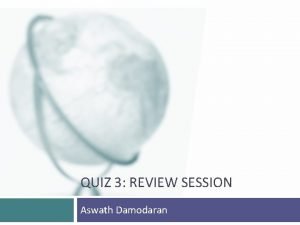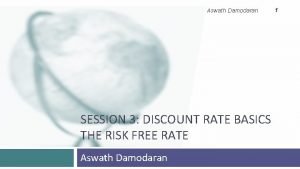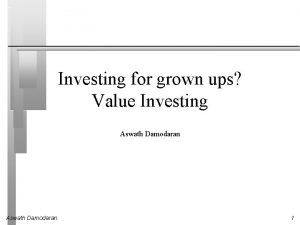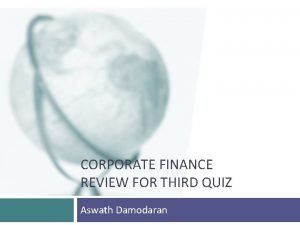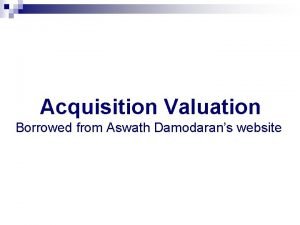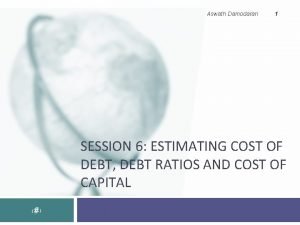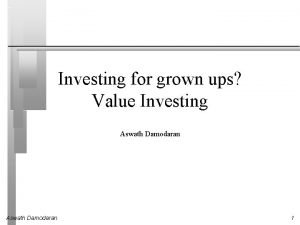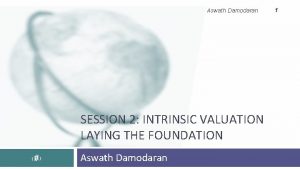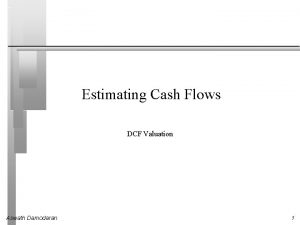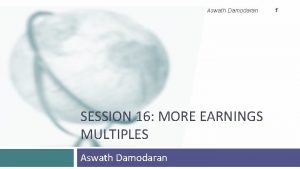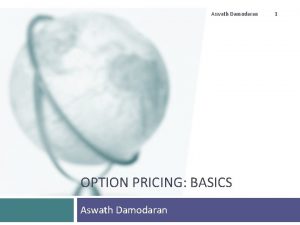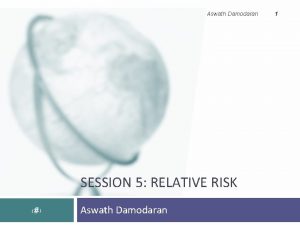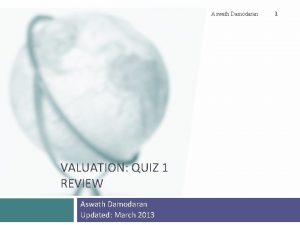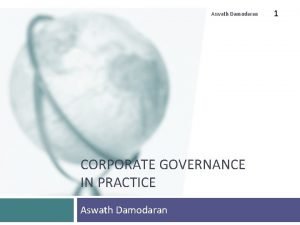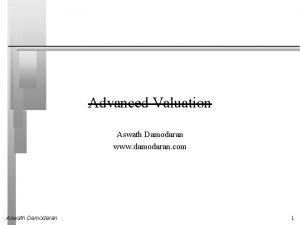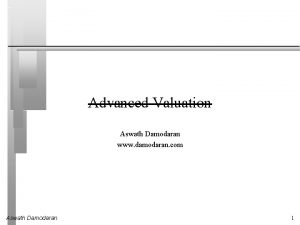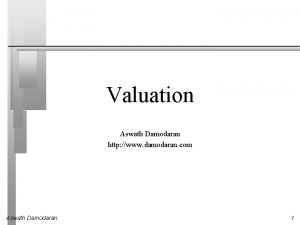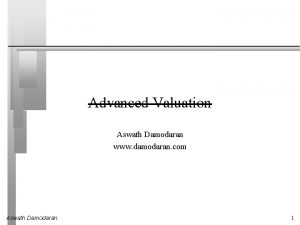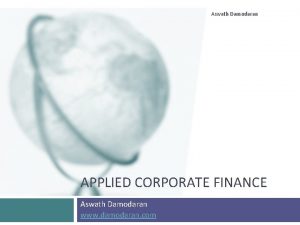Aswath Damodaran SESSION 23 THE OPTION TO DELAY













- Slides: 13

Aswath Damodaran SESSION 23: THE OPTION TO DELAY ‹#› 1

The Option to Delay 2 Aswath Damodaran 2

The Option to Delay PV of Cash Flows from Project Initial Investment in Project Present Value of Expected Cash Flows on Product Project has negative NPV in this section 3 Aswath Damodaran Project's NPV turns positive in this section 3

Example 1: Valuing product patents as options A product patent provides the firm with the right to develop the product and market it. It will do so only if the present value of the expected cash flows from the product sales exceed the cost of development. If this does not occur, the firm can shelve the patent and not incur any further costs. If I is the present value of the costs of developing the product, and V is the present value of the expected cashflows from development, the payoffs from owning a product patent can be written as: Payoff from owning a product patent = V - I if V> I =0 if V ≤ I 4 Aswath Damodaran 4

Payoff on Product Option Net Payoff to introduction Cost of product introduction Present Value of cashflows on product 5 Aswath Damodaran 5

Obtaining Inputs for Patent Valuation

Valuing a Product Patent: Avonex Biogen, a bio-technology firm, has a patent on Avonex, a drug to treat multiple sclerosis, for the next 17 years, and it plans to produce and sell the drug by itself. The key inputs on the drug are as follows: � � � PV of Cash Flows from Introducing the Drug Now = S = $ 3. 422 billion PV of Cost of Developing Drug for Commercial Use = K = $ 2. 875 billion Patent Life = t = 17 years Riskless Rate = r = 6. 7% (17 -year T. Bond rate) Variance in Expected Present Values =s 2 = 0. 224 (Industry average firm variance for bio-tech firms) Expected Cost of Delay = 1/17 = 5. 89% The output from the option pricing model d 1 = 1. 1362 N(d 1) = 0. 8720 � d 2 = -0. 8512 N(d 2) = 0. 2076 Call Value= 3, 422 exp(-0. 0589)(17) (0. 8720) - 2, 875 exp(-0. 067)(17) (0. 2076)= $ 907 million � 7 Aswath Damodaran 7

The Real Options Test: Patents and Technology The Option Test: � � The Exclusivity Test: � � Patents restrict competitors from developing similar products Patents do not restrict competitors from developing other products to treat the same disease. The Pricing Test � � � Underlying Asset: Product that would be generated by the patent Contingency: If PV of CFs from development > Cost of development: PV - Cost If PV of CFs from development < Cost of development: 0 Underlying Asset: Patents are not traded. Not only do you therefore have to estimate the present values and volatilities yourself, you cannot construct replicating positions or do arbitrage. Option: Patents are bought and sold, though not as frequently as oil reserves or mines. Cost of Exercising the Option: This is the cost of converting the patent for commercial production. Here, experience does help and drug firms can make fairly precise estimates of the cost. Conclusion: You can estimate the value of the real option but the quality of your estimate will be a direct function of the quality of your capital budgeting. It works best if you are valuing a publicly traded firm that generates most of its value from one or a few patents - you can use the market value of the firm and the variance in that value then in your option pricing model. 8 Aswath Damodaran 8

Example 2: Valuing Natural Resource Options In a natural resource investment, the underlying asset is the resource and the value of the asset is based upon two variables - the quantity of the resource that is available in the investment and the price of the resource. In most such investments, there is a cost associated with developing the resource, and the difference between the value of the asset extracted and the cost of the development is the profit to the owner of the resource. Defining the cost of development as X, and the estimated value of the resource as V, the potential payoffs on a natural resource option can be written as follows: Payoff on natural resource investment 9 Aswath Damodaran =V-X =0 if V > X if V≤ X 9

Obtaining Inputs for Patent Valuation

Valuing Gulf Oil was the target of a takeover in early 1984 at $70 per share (It had 165. 30 million shares outstanding, and total debt of $9. 9 billion). It had estimated reserves of 3038 million barrels of oil and the average cost of developing these reserves was estimated to be $10 a barrel in present value dollars (The development lag is approximately two years). � The average relinquishment life of the reserves is 12 years. � The price of oil was $22. 38 per barrel, and the production cost, taxes and royalties were estimated at $7 per barrel. � The bond rate at the time of the analysis was 9. 00%. � Gulf was expected to have net production revenues each year of approximately 5% of the value of the developed reserves. The variance in oil prices is 0. 03. � 11 Aswath Damodaran 11

Valuing Undeveloped Reserves Inputs for valuing undeveloped reserves � � � Value of underlying asset = Value of estimated reserves discounted back for period of development lag= 3038 * ($ 22. 38 - $7) / 1. 052 = $42, 380. 44 Exercise price = Estimated development cost of reserves = 3038 * $10 = $30, 380 million Time to expiration = Average length of relinquishment option = 12 years Variance in value of asset = Variance in oil prices = 0. 03 Riskless interest rate = 9% Dividend yield = Net production revenue/ Value of developed reserves = 5% Based upon these inputs, the Black-Scholes model provides the following value for the call: d 1 = 1. 6548 N(d 1) = 0. 9510 d 2 = 1. 0548 N(d 2) = 0. 8542 Call Value= 42, 380. 44 exp(-0. 05)(12) (0. 9510) -30, 380 (exp(-0. 09)(12) (0. 8542) = $ 13, 306 million 12 Aswath Damodaran 12

Valuing Gulf Oil In addition, Gulf Oil had free cashflows to the firm from its oil and gas production of $915 million from already developed reserves and these cashflows are likely to continue for ten years (the remaining lifetime of developed reserves). The present value of these developed reserves, discounted at the weighted average cost of capital of 12. 5%, yields: � Value of already developed reserves = 915 (1 - 1. 125 -10)/. 125 = $5065. 83 Adding the value of the developed and undeveloped reserves Value of production in place Total value of firm Less Outstanding Debt Value of Equity Value per share 13 Aswath Damodaran = $ 13, 306 million = $ 5, 066 million = $ 18, 372 million = $ 9, 900 million = $ 8, 472/165. 3 = $51. 25 13
 Aswath damodaran multiples
Aswath damodaran multiples Damodaran statistics
Damodaran statistics Aswath damodaran discount rate
Aswath damodaran discount rate Damodaran value investing
Damodaran value investing Damodaran discount rates
Damodaran discount rates Aswath damodaran review
Aswath damodaran review Damodaran portfolio
Damodaran portfolio Www.damodaran
Www.damodaran Damodarans
Damodarans Synthetic rating damodaran
Synthetic rating damodaran Aswath damodaran value investing
Aswath damodaran value investing Aswath damodaran intrinsic value
Aswath damodaran intrinsic value Non cash working capital dcf
Non cash working capital dcf Damodaran ebitda
Damodaran ebitda
